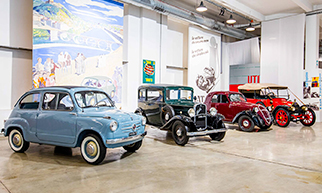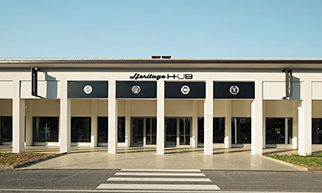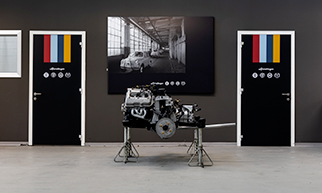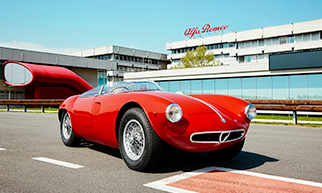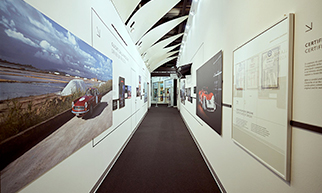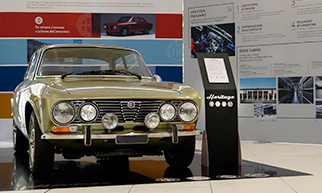Engines have started to roar for the 43rd historical re-enactment of the “1000 Miglia”—the “most beautiful race in the world” according to Enzo Ferrari—which will kick off in Brescia on June 17th and return on June 21st, following stops in some Italy’s most stunning towns.
Long regarded as part race and part adventure, this year’s 1000 Miglia will feature over 400 classic cars from 29 countries—with 18 Alfa Romeos standing out among the 127 pre-war models. Notably, this year’s 1,9000-km itinerary will unfold along a “figure-eight” route inspired by the first 12 editions of the 1000 Miglia speed race.
Stellantis Heritage could not miss out on such a prestigious event. Thanks to its support, three exemplary models from Alfa Romeo, Fiat, and Maserati—undisputed legends of Italian motorsport—will participate in the event. The starting grid will feature the 1956 Alfa Romeo 1900 Super Sprint, the sporty coupé preferred by gentlemen drivers in the 1960s, which comes directly from the Alfa Romeo Museum in Arese. Nearby, there will also be the 1955 Fiat 600, usually housed in the Centro Storico Fiat in Turin, which is a symbol of the 1960s’ Italian economic miracle and currently celebrating its 70th anniversary. This special occasion makes the 1000 Miglia the ideal occasion for the brand to celebrate the iconic model—a central figure in both Italy’s and its own history—and to pay homage to the many privately-owned Fiat 600s that took part in the historic 1000 Miglia. Rounding out this exceptional trio is the Maserati A6 GCS, owned by a private collector. Notably driven by celebrated champions such as Luigi Musso, it is believed to be the Maserati with the highest number of participations in the 1000 Miglia speed race—including the final one in 1957.
In the 1000 Miglia 2025, the three exemplary classic cars will be joined along the route by modern “Support Cars” from their respective brands. Alfa Romeo will participate with the Giulia Quadrifoglio Super Sport—the special limited-edition series dedicated to the brand’s 1st victory at the 1000 Miglia. They will also showcase the Tonale—the brand’s first electrified SUV—and the New 33 Stradale, a limited-series model crafted in collaboration with Touring Superleggera, seamlessly bridging its past and present lineups in pure Italian style. FIAT will line up a hybrid version of its New 600 with a dual-clutch automatic transmission. Meanwhile, Abarth will showcase the 280-hp 600e, its most powerful version ever. Lastly, the Support Cars will also include the stunning and charming GranTurismo Trofeo, Grecale Trofeo, and new GranCabrio 490—with the latter driven by the Director of Quattruote magazine, Gian Luca Pellegrini. All of the Modena-based brand cars will feature a special livery which pays tribute to the “Year of the Trident”, next year’s program of events celebrating Maserati’s 100th motorsport anniversary. Furthermore, four Stellantis employees—chosen via an in-company contest—will cover the race on board a Fiat 600 Hybrid and an Alfa Romeo Junior Q4 Hybrid, providing daily updates on this adventure for the entire community. Notably, the 1000 Miglia 2025 coincides with an important anniversary for Alfa Romeo: 95 years ago, Tazio Nuvolari and Giovanni Battista Guidotti triumphed at the 1000 Miglia on board the Alfa Romeo 6C 1750. Nuvolari’s first victory at the “world’s most beautiful race” also marked the first time a driver averaged 100 km/h over the entire competition—an even more incredible and memorable feat given the unpaved roads of the time.
Alfa Romeo 1900 Super Sprint (1956)
The starting grid had to include the iconic 1956 Alfa Romeo 1900 Super Sprint, an elegant coupé that represents the “gran turismo” class of the 20th century—“the family car that wins races” in the words of the slogan that made it famous in the 1950s. Based on the short version chassis of the 1900 sedan, it is fitted with a 2-liter, 4-cylinder engine with the brand’s trademark twin camshaft that delivers 115 hp at 5,500 rpm. In the 1950s, it was customary for the great Italian designers to buy a mechanized chassis from Alfa Romeo, complementing it with bodywork designed and produced in-house—exactly what the Touring coachbuilder did. Between 1955 and 1958, it produced 858 models of this series of the 1900 Sprint. Drivers and private racing teams at the time considered the 1900 Sprint to be an effective car for achieving class victories: its road holding, speed, and reliability made it mainly a winner in the Turismo class. In this edition of the Red Arrow, the extraordinary model will be driven by a special team, whose announcement in the coming days is sure to excite the Alfa Romeo fans from around the world.
Fiat 600D (1955)
On the occasion of the model’s 70th anniversary, the starting grid will also feature a charming, light-blue Fiat 600 from the first 1955 series, usually housed at the Centro Storico Fiat in Turin. It will be driven by the all-female crew made up of Laura Confalonieri, Assistant Director of Ruoteclassiche, and Valentina Menassi, a journalist and contributor at Il Giornale. The car instantly evokes memories of the many privately-owned Fiat 600s from the 1960s that confidently took on the race in the so-called “minor classes”—proving that the 1000 Miglia was not only for elite drivers, but was also open to all true enthusiasts. Tracing this model’s history means going back in time and paying homage to Dante Giacosa, FIAT’s most celebrated designer—born 120 years ago—who created iconic models such as the Topolino, the 600, and the 500. In particular, the Fiat 600 was designed to bring widespread mobility to post-war Italy, first supporting and later overtaking the 500 “Topolino”. Designed by Giacosa, it represents a technical and economical turning point thanks to the choice of a rear engine and traction. The new 633-cc and 21.5-hp Tipo 100 engine guaranteed agility, lightness, and low costs. The body was load-bearing and the suspensions independent, with every aspect of the project aimed at maximizing efficiency. There was no lack of original and creative solutions, including the headlights—originally placed on the hood and later moved to the fenders to simplify production—and the rear-hinged doors, which were fitted with three-part windows—including one in plexiglass which could open vertically inwards as a deflector. Under the front bonnet were the petrol tank, spare wheel, and a space for small baggage. The simple yet ingenious passenger compartment could be made larger by folding down the rear seat. Unveiled at the 1955 Geneva Motor Show, it instantly won over the public with its modern lines, four seats, 95 km/h speed, and affordable price. Technical and stylistic advancements followed, including the renowned 1956 600 Multipla, the precursor to the modern minivan. Production continued even after the arrival of the Fiat 850 in 1964, with which it exchanged various elements. In total, over 4.9 million models were produced in Italy and abroad. It is important to note that the quality of the “Tipo 100” project meant the 600’s engine continued to evolve over the years, constantly increasing in power and being repurposed for other Fiat models: from the 850 to the 127, from the first Autobianchi A112 Abarth 58 HP to the Panda 45 and the Fiat Uno 45, passing the baton to the FIRE engines in the mid-1980s but remaining unused until the 2000s. And this extended far beyond the engine: the 600’s frame and chassis would also prove their worth in the unbeatable tune-ups created by Abarth, the 850 and 1000 TC, which would go on to write chapters in the history of the Scorpion brand on circuits all over the world.
Maserati A6 GCS/53 (1953)
Maserati rewrites the script of the 1000 Miglia by bringing a car that has already made its mark on the race: the A6 GCS/53 with chassis n. 2043—the very same that took part in the last edition of the race in 1957. A comeback that unites passion and memory, Maserati Classiche will provide official support to the crew during the entire competition. The model belongs to the private collection of a Maserati enthusiast and connoisseur. It took part in 5 consecutive editions of the 1000 Miglia speed race from 1953 to 1957—in all likelihood making it the Maserati with the highest number of appearances in the most iconic historic motorsport race. Currently undergoing the Certification of Authenticity process by Maserati Classiche, the vehicle is distinguished by one of the longest competitive careers of its time and a roster of highly skilled drivers, including the world-famous Luigi Musso. The Maserati A6 GCS/53, aka the Sport 2000, was created to bring the Trident back to top of the Sport 2-liter category. From early 1953, the vehicle established itself as one of the most sought-after cars among up-and-coming Italian and foreign talents, with 53 models constructed in two years. The A6 GCS/53 achieved its first significant success at the 1000 Miglia, when Giletti came in sixth place overall and first in the Sport 2-liter category. Even if it never won the competition outright, it carved out a special place in the hearts of fans. Its state-of-the-art design choices set it apart from a technical point of view: its short-stroke, twin-ignition “Superquadro” engine, twin overhead camshafts, and gear train guaranteed it higher rotational speeds. Seventy years since its debut, the A6 GCS/53 is back and ready to once again take on the roads of the Red Arrow— not merely for nostalgia, but to deliver thrills and excitement in true Trident fashion.
Past and future: on the road together
Along the 1000 Miglia route, the three classic cars will be followed by the latest releases from each brand, which will act as Support Cars. For instance, the brand that has embodied noble Italian sportiness since 1910 will showcase a spirited Giulia Quadrifoglio, the sports sedan which reflects a century-long pursuit of technical excellence applied to both racing and production vehicles. It will be accompanied by the Alfa Romeo Tonale, the C-SUV that marks the brand’s entrance into the era of electrification. Recently, it surpassed the 100,000 units produced milestone in Stellantis’ Pomigliano d’Arco plant—a true symbol of Italian manufacturing excellence. The spotlight will surely be on the New 33 Stradale, driven by its owner along the Red Arrow route—a car built to deliver high performance on and off the track. Notably, just like the 1900 Super Sprint in competition, the Biscione’s new limited-edition series has been made in collaboration with the Milan-based coachbuilder, Touring Superleggera, in a world-exclusive production process that takes craftsmanship and innovation to whole new levels. Moreover, the Stellantis’ Support Cars will also include the Abarth 600e and the Fiat 600. The former is Abarth’s most powerful car ever with 280 hp and 0-to-100 acceleration in just 5.85 seconds. Developed in collaboration with Stellantis Motorsport, it marks an important step forward for Abarth, setting a new standard for electric hot hatches. Meanwhile, the Fiat 600 Hybrid ensures an extremely smooth driving experience, allowing customers to enjoy electric mobility at a higher speed than 30 km/h on both city and country roads, as well as on the highway when the driver eases off the pedal in stable conditions or when going downhill. The advantage of this new hybrid technology includes lower emissions, less noise pollution, greater comfort, and more enjoyment thanks to the fluidity of the automatic dual-clutch transmission. Aesthetically intriguing and technologically advanced, the Fiat 600 is spacious at 4.17 meters in length, features 5 doors, comfortably seats 5 people, and offers 15 liters of interior storage, including best-in-class front storage and a trunk with 385 liters of load capacity. Thus, the historic 600s which competed in the 1960s’ 1000 Miglia can pass the torch to their current heirs, which are confidently and optimistically focused on the future. Lastly, three charming and elegant Maserati—a GranCabrio 490, a GranTurismo Trofeo, and a Grecale Trofeo, each featuring a special livery that pays home to the Year of the Trident—will be included among the Stellantis’ Support Cars that will accompany the three historic vehicles in competitions.
A one-of-a-kind experience four Stellantis employees
For the 2025 edition of the 1000 Miglia, Stellantis launched an in-company contest for all its Enlarged Europe employees to give them the once-in-a-lifetime chance to actively participate in the world’s most beautiful race, following the classic vehicles in Support Cars. Promoted by Internal Communication in collaboration with Heritage and the participating brands, the initiative invited employees to record a short video explaining what the 1000 Miglia meant to them and why they deserved the opportunity to take part in this unique experience. The response was overwhelming from employees around Europe. Four employees from Italy, France, Germany, and Poland were chosen based on their passion, creativity, and motivation. The winners--Luca, Nathalie, Marcin e Lukasz—will follow the entire 1000 Miglia 2025 route, experiencing each leg as drivers or co-drivers in the “support cars” on board a Fiat 600 Hybrid or an Alfa Romeo Junior Hybrid Q4—the only premium compact car to also offer a Q4 all-wheel drive variant with automated rear-wheel drive axle management. Furthermore, during the five race days, they will create content to share their everyday experience, broadcasting the spirit, energy, and emotion of this extraordinary adventure to the entire Stellantis community.
5 days, 1,000 emotions: the 1000 Miglia 2025 traverses Italian history, landscapes, and passion
Ready to write yet another legendary chapter in its history, the most prestigious traveling museum in the world departs Brescia on June 17th. On the first day of the Red Arrow, the vehicles will make their way through the landscape of Lombardy and Veneto, passing by Desenzano, Sirmione, Verona, Bovolone and Ferrara, before ending the day in San Lazzaro di Savena near Bologna. On the following day, the crews will take on the stunning Raticosa and Futa Passes, exploring the green heart of the Apennine Mountains. The route will then lead them through Prato and Siena towards the Eternal City of Rome, where the second day will come to a close. After the turnaround in the Italian capital, the third day will bring the crews back north, where they will head to Orvieto, Foiano della Chiana, Arezzo and San Sepolcro, followed by a return to San Marino and the day’s final destination of Cervia-Milano Marittima on the Adriatic coast. On the fourth day, the race will cross the entirety of Italy from east to west. After the departure from Cervia and a drive through Forlì, the route will cut across the Apennines to Empoli, coming into perfect contact with the descent route taken towards Rome. The route will move on to Pontedera towards the Tyrrhenian coast on what is sure to be one of its most memorable moments: the passage through the Italian Naval Academy in Livorno. From there, the ascent will head north through Viareggio and the Cisa Pass and arrive in Parma. On the fifth and final day, the caravan will set course for Brescia—back where it all began. The public will eagerly await the roar of the engines which, once again, will have once again traversed Italy, celebrating the passion, elegance, and timeless spirit of the most beautiful race in the world.
